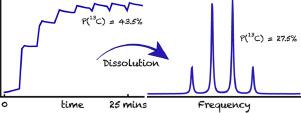Journal of Magnetic Resonance Open Pub Date : 2021-07-25 , DOI: 10.1016/j.jmro.2021.100018 Stuart J. Elliott 1, 2 , Olivier Cala 1 , Quentin Stern 1 , Samuel F. Cousin 1, 3 , Morgan Ceillier 1 , Venita Decker 4 , Sami Jannin 1

|
Dissolution-dynamic nuclear polarization can be boosted by employing multiple-contact cross-polarization techniques to transfer polarization from 1H to 13C spins. The method is efficient and significantly reduces polarization build-up times, however, it involves high-power radiofrequency pulses in a superfluid helium environment which limit its implementation and applicability and prevent a significant scaling-up of the sample size. We propose to overcome this limitation by a stepwise transfer of polarization using a low-energy and low-peak power radiofrequency pulse sequence where the 1H→13C polarization transfer is mediated by a dipolar spin order reservoir. An experimental demonstration is presented for [1-13C]sodium acetate. A solid-state 13C polarization of ∼43.5% was achieved using this method with a build-up time constant of ∼5.1 minutes, leading to a ∼27.5% 13C polarization in the liquid-state after sample dissolution. The low-power multiple-step polarization transfer efficiency achieved with respect to the most advanced and highest-power multiple-contact cross-polarization approach was found to be ∼0.69.
中文翻译:

通过多步偶极有序介导的 1H→13C 交叉极化促进溶解动态核极化
通过采用多接触交叉极化技术将极化从1 H转移到13 C 自旋,可以促进溶解动态核极化。该方法是有效的,并显着减少了极化建立时间,但是,它涉及超流氦环境中的高功率射频脉冲,这限制了其实施和适用性,并防止了样本大小的显着扩大。我们建议通过使用低能量和低峰值功率射频脉冲序列逐步转移极化来克服这一限制,其中1 H→ 13 C 极化转移由偶极自旋顺序储存器介导。为 [1- 13C]醋酸钠。使用这种方法实现了约 43.5%的固态13 C 极化,建立时间常数为约 5.1 分钟,导致样品溶解后液态13 C 极化为约 27.5% 。发现相对于最先进和最高功率的多接触交叉极化方法实现的低功率多步极化转移效率约为 0.69。



























 京公网安备 11010802027423号
京公网安备 11010802027423号